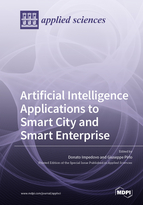Artificial Intelligence Applications to Smart City and Smart Enterprise
A special issue of Applied Sciences (ISSN 2076-3417). This special issue belongs to the section "Computing and Artificial Intelligence".
Deadline for manuscript submissions: closed (31 January 2020) | Viewed by 103940
Special Issue Editors
Interests: artificial intelligence; pattern recognition; signal processing; biometrics; automatic signature verification
Special Issues, Collections and Topics in MDPI journals
Interests: biometrics; automatic signature verification; artificial intelligence; pattern recognition; signal processing
Special Issues, Collections and Topics in MDPI journals
Special Issue Information
Dear Colleagues,
The existence of smart cities requires a new organization structure that takes into account every aspect of how a city runs. Smart cities work under a more resource-efficient management and economy than ordinary cities. As such, advanced business models have emerged around smart cities, which lead to the creation of smart enterprises or organizations that depend on advanced software and computer applications. Smart cities and smart enterprises deal with the integration of artificial intelligence, web technologies, smart mobile platforms, telecommunications, e-commerce, e-business, and other technologies. Fields of applications are related to services for users and citizens, such as transportation, buildings, e-health, utilities, etc.
Prof. Eng. Donato IMPEDOVO
Prof. Giuseppe PIRLO
Guest Editors
Manuscript Submission Information
Manuscripts should be submitted online at www.mdpi.com by registering and logging in to this website. Once you are registered, click here to go to the submission form. Manuscripts can be submitted until the deadline. All submissions that pass pre-check are peer-reviewed. Accepted papers will be published continuously in the journal (as soon as accepted) and will be listed together on the special issue website. Research articles, review articles as well as short communications are invited. For planned papers, a title and short abstract (about 100 words) can be sent to the Editorial Office for announcement on this website.
Submitted manuscripts should not have been published previously, nor be under consideration for publication elsewhere (except conference proceedings papers). All manuscripts are thoroughly refereed through a single-blind peer-review process. A guide for authors and other relevant information for submission of manuscripts is available on the Instructions for Authors page. Applied Sciences is an international peer-reviewed open access semimonthly journal published by MDPI.
Please visit the Instructions for Authors page before submitting a manuscript. The Article Processing Charge (APC) for publication in this open access journal is 2400 CHF (Swiss Francs). Submitted papers should be well formatted and use good English. Authors may use MDPI's English editing service prior to publication or during author revisions.
Keywords
- Application, deployment, testbed, and experiment experiences in smart cities
- Big data for urban informatics
- Cloud computing and network infrastructure that supports smart cities
- Cellular networking in smart cities
- Delay tolerant networks and systems for urban data collection
- E-health systems
- Environment and urban monitoring
- Enabling wireless and mobile technologies for smart cities
- Fault tolerance, reliability, and survivability in smart systems
- Green computing, networking, and energy efficiency
- Human mobility modeling and analytics
- Mobile crowdsourcing for urban analytics
- QoS and QoE of smart city systems, applications, and services
- Sensing and IoT for smart cities
- Social computing and networks
- Software defined networking (SDN) and network function virtualization (NFV) in a smart city environment
- Smart grid
- Smart transportation
- Smart buildings
- Safety, security, and privacy for smart cities
- Smartphone and mobile systems and applications
- Vehicular networks
- Collaboration and Negotiation Technologies
- Multi-Agent Systems and Artificial Intelligence
- e-Business and e-Commerce
- Semantic Web
- Intelligent Web Applications
- Ubiquitous Computing
- Cloud Computing
- Collective Intelligence
- Green Computing
- Surveys on Sustainable Information Systems







